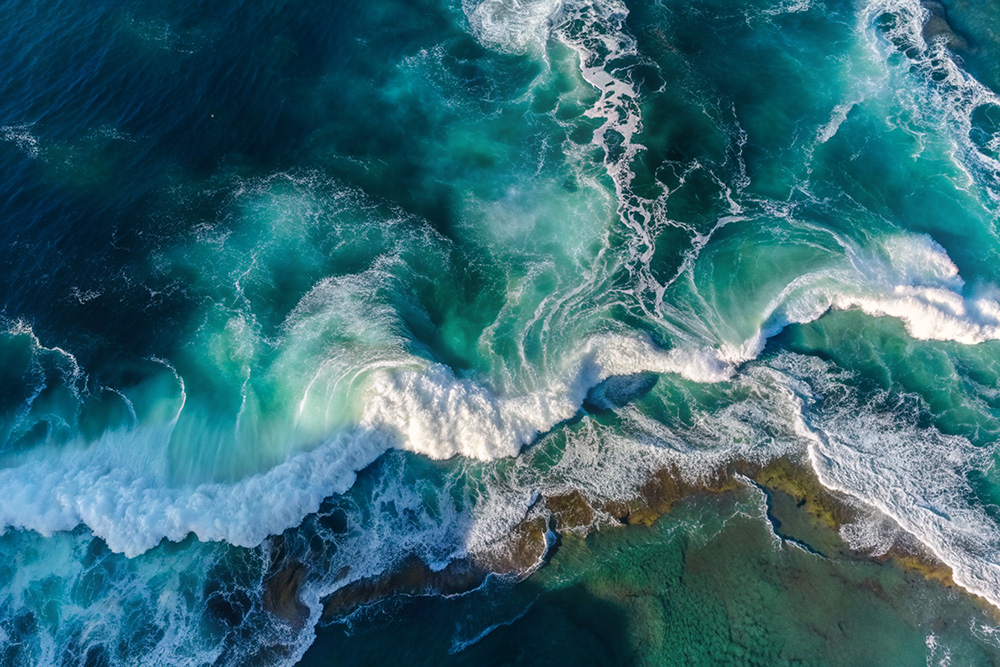
Glossary of Terms
A to Z of ocean health (and pollution solutions) – a beginners guide
A
Aquatic - living or growing in water.
B
Biodiversity - short for biological diversity - the variety of living species on earth and their interactions, including plants, animals and fungi. It is susceptible to change over time through extinction.
Bioassay - a measurable growth response assessment using a chemical or biological test organism, such as protein inhibition or activation.
Biomarker (an indicator like a heartbeat) - short for biological marker - a naturally occurring molecule, gene or characteristic measured in the body that influences or predicts disease, pathological or physiological processes.
Biocides - short for biocidal products - a chemical substance or mixture used to destroy plants, animals or microorganisms through a chemical or biological action.
Biotransformation - the process by which a chemical is changed from one chemical into another to remove contamination from soil or water systems.
Bioaccumulation - the process describing chemical build-up over time in a living organism - often associated with accumulation of harmful chemicals.
Bioplastics - manufactured plastic derived from renewable (biological) sources as an environmentally conscious alternative to petroleum based plastic.
Blue economy - economic growth activities that promote sustainable use of ocean resources whilst preserving ocean health.
Bisphenols - an industrial chemical compound produced on a large-scale for use in polycarbonate plastics (hard plastics).
Biomagnification - accumulation and transfer of toxic chemicals via food webs. The chemicals travel up the food chain causing serious health concerns in animals.
C
Carcinogenic - physical, chemical or biological organisms or substances that have the potential to cause cancer.
Chemical analysis - the process of determining the physical and chemical components of a sample to further understand its matter.
Chemical fate - the way in which a chemical, when released into the environment is chemically transformed and presented as a potentially hazardous substance.
Chemical transportation / circulation - a process in which chemicals are moved from one location to another, often resulting in harmful chemical byproducts.
Coastal - a place or object on land or in the sea that is located near to the coast.
Contaminant - any physical, chemical, biological or radiological substance that makes a place or substance no longer fit for use (e.g. water, food, air).
Climate impacts - the adverse long-term effects of climate change, including: changes in precipitation, rising sea levels, increased global temperature, pH and more frequent extreme weather events.
Clean seas / Mission Ocean (by 2030) - the European Union’s aim to “restore our Ocean and waters” by the target year, 2030.
Cocktail effect - the combination of several chemical pollutants creating toxic water or products in which people and/or wildlife are impacted by.
Chemical compounds - a substance composed of identical molecules made up of two or more chemical elements.
Coagulation - a wastewater treatment process used to remove solids from water using neutralisation.
Carbon intensive - a measure of carbon dioxide and greenhouse gases (in grams) used to analyse how environmentally friendly different types of energy are.
D
Deep sea - the part of the ocean that is further than 200m down, where light begins to fade (mainly below the continental shelf edge).
Dose - A measurement amount for a substance added during a process.
Dead zones - An area of water where oxygen levels are reduced, often causing species and biodiversity loss (where living organisms cannot sustain).
E
Ecotoxicology - the study of toxic effects of chemicals caused by pesticides and other pollutants that contaminate ecosystems, impacting plants and animals.
eDNA - short for environmental DNA - is genetic material (skin cells, mucus, faeces) shed by organisms that is found in water, soil and air.
Emerging pollutants - a group of chemical and biological agents that are extremely hazardous, even in trace amounts, to humans and wildlife.
Endocrine disruptors - chemicals in consumer products that interfere with the hormones in the endocrine system. Exposure to them can have serious effects on both humans and wildlife.
Exposure - when chemicals enter the body causing adverse health effects. It occurs through having contact with harmful chemical substances found in aquatic and terrestrial environments.
Ecosystem - a complex group of plants, animals and other organisms that interact in an environment.
Eutrophication - a process by which gradual increased concentrations of chemicals cause over enrichment of an environment, leading to harmful growth of algal blooms and dead zones.
F
Fluoropolymers - a polymer consisting of carbon and fluorine - high-performance strong plastics with desirable properties.
Forever chemicals - a large group of chemical substances that are persistent in the environment and do not occur in nature, often causing environmental issues.
Freshwater - a body of water that does not contain salt.
G
Groundwater - water collected beneath the Earth’s surface caused by pores in underground materials.
H
Hazard - chemicals that pose serious threats to the health of humans and wildlife or environmental harm due to their chemical properties.
I
In silico - experimentation performed in or on a computer using computer software.
In vitro - experimentation performed outside of the body in artificial conditions/ an artificial environment (in a laboratory).
In vivo - experimentation occurring inside the living body of a plant or animal (opposite to in vitro).
J
K
L
Long-chain chemicals - Per- flourinated chemicals (PFC’s) with carbon lengths C8 and above. This includes PFAS’s, PFCA’s and PFSA’s.
M
Mixtures - a combination of numerous harmful environmental chemical compounds, resulting in concoctions harmful to humans and animals.
Marine - in relation to the sea: existing in, or produced by the sea.
Meiofauna - small invertebrates that inhabit both freshwater and marine environments e.g. tiny worms or crustaceans.
Microscopic - an organism so small, it is only distinguishable through a microscope.
Mesocosm - an experimental water ecosystem that can be manipulated with environmental factors to observe scientific outcomes under controlled conditions.
Microcosm -
Mode of action / mechanism - a set of physiological and behavioural signs found in various levels of biological organisation that apply functional change at a cellular level, resulting in adverse biological responses.
Marine Strategy Directive - the European Union’s tool that aims to improve the environmental status of the EU’s marine waters through protecting and conserving the health of coasts, seas and oceans.
N
Novel compounds - new anthropogenically engineered substances and chemicals found mostly in air, soil, water and food. They can pose serious threats to humans/animals and are predominantly unregulated.
Neurotoxic - synthetic or naturally occurring substances that enter the body from environmental sources, and cause adverse changes to the nervous system.
Nanogram - one billionth of a gram.
Nanofiltration - a technological filtration process where a substance is filtered through nanometre sized holes to retain organic matter within water.
O
Ocean literacy - a concept used to increase awareness and encourage ocean activism. It is a concept based on individual and collective influence on the ocean and the ocean’s influence on you.
Ocean modelling - a series of interconnected numerical scales that study physical, chemical, and biological interactions.
Omics - a data-centred approach using large-scale technologies used to characterise biological molecules.
Ozone layer - a layer in the Earth’s stratosphere containing highly reactive gas (ozone) that can absorb ultraviolet radiation.
P
Persistence - contaminants that are slow to break down in an ecosystem, some of which are toxic; posing significant health threats to humans, animals and the environment.
Pollution hotspot - areas of excess chemical pollution that endanger the environment and contribute to health risks caused by overexposure of harmful chemicals.
Priority pollutants - a set of chemical pollution regulations propositioned by the Environmental Protection Agency
Pharmaceuticals - manufactured compounds for medicinal use, such as antibiotics.
Personal care products – PCPs - consumer chemical compound products that can be applied to various parts of the body externally, often used for wellbeing and beauty.
Plastic additives - materials added to the manufacturing process to achieve better material performance as their characteristics can be modified for specific purposes. They are able to leach into the environment causing ecological impacts.
PFAS - a group of synthetic chemicals that are found in various products, some of which can be detrimental to the environment.
PFOS - Perfluorooctane sulfonate - part of the PFAS group.
PFOA - Perfluorooctanic acid - part of the PFAS group.
PFHxS - Perfluorohexanesulfonic acid - part of the PFAS group.
Petrochemicals - any chemical substance derived from fossil fuels such as natural gas or petroleum e.g. methane, propane and hydrogen.
Pesticides - harmful chemical substances used to harm plants, insects and small animals. They are often used on farms to protect crops.
Q
Quats - quaternary ammonium compounds (QAC’s) - a group of disinfectant chemicals used in preservation and household cleaners to combat germs.
R
ROV – remote operated vehicle to collect deepwater sample -unoccupied underwater vehicle, connected to a vessel on the surface that explores ocean depths and other small-scale underwater observational studies.
Reverse osmosis - a chemical process by which water is demineralised using a pressured separation technique through a semipermeable membrane that prevents large molecules and impurities from passing through.
Run-off - the movement of untreated contaminants and water that impact land and waters; usually consisting of chemicals, pesticides and fertilisers.
S
Sediment - a material that is deposited by water, wind or glaciers and moved to a new location, often consisting of plants, rocks, animals and minerals.
Synthetic chemicals - chemicals created anthropogenically using un-natural methods to chemically change a substance extracted from a plant, animal or mineral source.
Smart solutions - data driven systems that combine intelligence and innovative technologies to enhance systems.
Short-chain chemicals - Per- and polyfluoroalkyl substances (pFAS) - non polymers with carbon lengths C6 and below.
Sludge - a muddy deposit usually consisting of industrial or chemical by-products, it is often found in waste-treatment plants and refineries.
T
Toxic vs toxin - toxic describes artificial synthetic substances introduced by human activity. Whereas, toxin describes natural products that create poisonous foods or venom (produced by natural elements).
Technology-critical elements (TCEs) - a set of 30 geological minerals and elements crucial to sustainable technological advancement across the world.
Toxification - habitat alteration caused by hazardous chemical pollutant reactions creating adverse impacts on ecosystems.
U
Ultra-violet rays - non-ionising radiation undetectable by the human eye, that is emitted from the sun or artificial light sources.
V
Volatile organic compounds/chemicals - a variety of chemical compounds released as gases, that have low water solubility and high vapour pressure.
W
Wastewater - Water that has been previously used, often containing chemicals from factories, homes and farms.
X
Xylenes - three colourless, toxic and flammable compounds used in leather, rubber and as a cleaning agent.
Y
Z
Zero pollution ambition - the European Union policy set to reduce water, air and soil pollution to a non-harmful level by 2050, in the hopes of creating a toxic-free environment.
